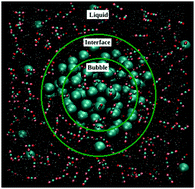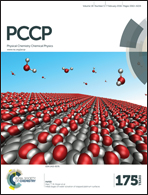Carbon dioxide induced bubble formation in a CH4–CO2–H2O ternary system: a molecular dynamics simulation study†
Abstract
The extraction of methane from its hydrates using carbon dioxide involves the decomposition of the hydrate resulting in a CH4–CO2–H2O ternary solution. Using classical molecular dynamics simulations, we investigate the evolution of dissolved gas molecules in the ternary system at different concentrations of CO2. Various compositions considered in the present study resemble the solution formed during the decomposition of methane hydrates at the initial stages of the extraction process. We find that the presence of CO2 aids the formation of CH4 bubbles by causing its early nucleation. Elucidation of the composition of the bubble revealed that in ternary solutions with high concentration of CO2, mixed gas bubbles composed of CO2 and CH4 are formed. To understand the role of CO2 in the nucleation of CH4 bubbles, the structure of the bubble formed was analyzed, which revealed that there is an accumulation of CO2 at the interface of the bubble and the surrounding water. The aggregation of CO2 at the bubble–water interface occurs predominantly when the concentration of CO2 is high. Radial distribution function for the CH4–CO2 pair indicates that there is an increasingly favorable direct contact between dissolved CH4 and CO2 molecules in the bubble–water interface. It is also observed that the presence of CO2 at the interface results in the decrease in surface tension. Thus, CO2 leads to greater stability of the bubble–water interface thereby bringing down the critical size of the bubble nuclei. The results suggest that a rise in concentration of CO2 helps in the removal of dissolved CH4 thereby preventing the accumulation of methane in the liquid phase. Thus, the presence of CO2 is predicted to assist the decomposition of methane hydrates in the initial stages of the replacement process.


 Please wait while we load your content...
Please wait while we load your content...